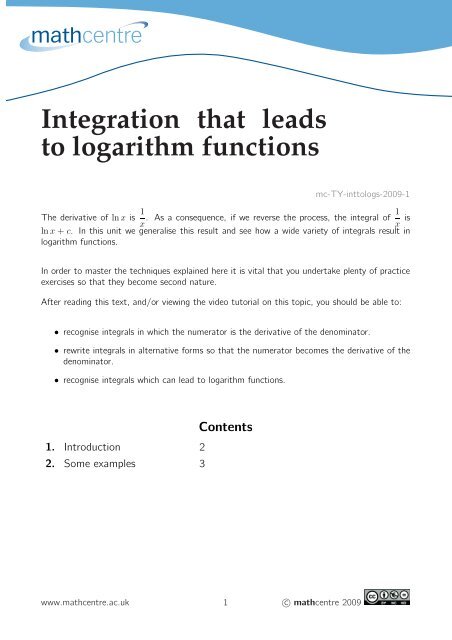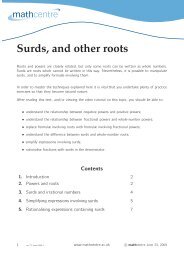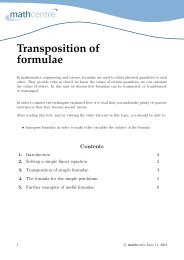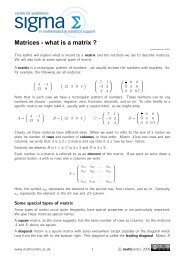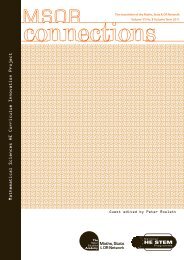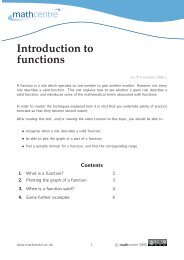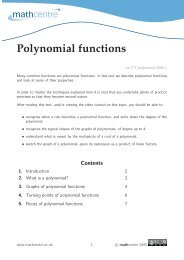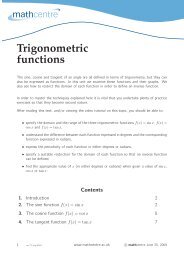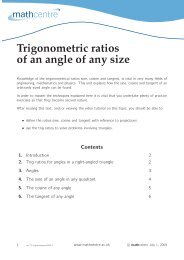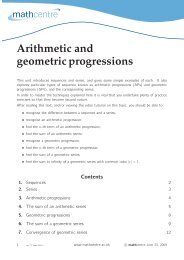Integration that leads to logarithm functions - Mathcentre
Integration that leads to logarithm functions - Mathcentre
Integration that leads to logarithm functions - Mathcentre
You also want an ePaper? Increase the reach of your titles
YUMPU automatically turns print PDFs into web optimized ePapers that Google loves.
<strong>Integration</strong> <strong>that</strong> <strong>leads</strong><strong>to</strong> <strong>logarithm</strong> <strong>functions</strong>mc-TY-int<strong>to</strong>logs-2009-1Thederivativeof ln xis 1 x . Asaconsequence,ifwereversetheprocess,theintegralof 1 x isln x + c. Inthisunitwegeneralisethisresultandseehowawidevarietyofintegralsresultin<strong>logarithm</strong><strong>functions</strong>.Inorder<strong>to</strong>masterthetechniquesexplainedhereitisvital<strong>that</strong>youundertakeplentyofpracticeexercisesso<strong>that</strong>theybecomesecondnature.Afterreadingthistext,and/orviewingthevideotu<strong>to</strong>rialonthis<strong>to</strong>pic,youshouldbeable<strong>to</strong>:•recogniseintegralsinwhichthenumera<strong>to</strong>risthederivativeofthedenomina<strong>to</strong>r.•rewriteintegralsinalternativeformsso<strong>that</strong>thenumera<strong>to</strong>rbecomesthederivativeofthedenomina<strong>to</strong>r.•recogniseintegralswhichcanlead<strong>to</strong><strong>logarithm</strong><strong>functions</strong>.1. Introduction 22. Someexamples 3Contentswww.mathcentre.ac.uk 1 c○mathcentre2009
1. IntroductionWealreadyknow<strong>that</strong>whenwedifferentiate y = ln xwefind dydx = 1 x .Wealsoknow<strong>that</strong>ifwehave y = ln f(x)andwedifferentiateitwefind dydx = f ′ (x)f(x) .Thepointis<strong>that</strong>ifwerecognise<strong>that</strong>thefunctionwearetrying<strong>to</strong>integrateisthederivativeofanotherfunction,wecansimplyreversetheprocess.Soifthefunctionwearetrying<strong>to</strong>integrateisaquotient,andifthenumera<strong>to</strong>risthederivativeofthedenomina<strong>to</strong>r,thentheintegralwillinvolvea<strong>logarithm</strong>:and,reversingtheprocess,if y = ln f(x)so<strong>that</strong>∫ f ′ (x)dx = ln(f(x)) + c.f(x)dydx = f ′ (x)f(x)Thisprocedureworksifthefunction f(x)ispositive,becausethenwecantakeits<strong>logarithm</strong>.Whathappensifthefunctionisnegative? In<strong>that</strong>case, −f(x)ispositive,so<strong>that</strong>wecantakethe<strong>logarithm</strong>of −f(x).Then:if y = ln(−f(x))so<strong>that</strong>dydx = −f ′ (x)−f(x) = f ′ (x)f(x)and,reversingtheprocess,whenthefunctionisnegative.∫ f ′ (x)dx = ln(−f(x)) + cf(x)Wecancombineboththeseresultsbyusingthemodulusfunction.Thenwecanusetheformulainbothcases,orwhenthefunctiontakesbothpositiveandnegativevalues(orwhenwedon’tknow).Key PointTointegrateaquotientwhenthenumera<strong>to</strong>risthederivativeofthedenomina<strong>to</strong>r,weuse∫ f ′ (x)dx = ln |f(x)| + c.f(x)www.mathcentre.ac.uk 2 c○mathcentre2009
2. Some examplesExample∫Find tan x dx.Recall<strong>that</strong>wecanrewrite tan xas sin x .Observe<strong>that</strong>thederivativeof cosxis − sin x,so<strong>that</strong>cosxthenumera<strong>to</strong>risverynearlythederivativeofthedenomina<strong>to</strong>r.Wemakeitsobyrewriting sin xcos xas − − sin xcosx andtheintegralbecomes∫∫ sin xtanxdx =cosx dx∫ − sin x= −cosx dx= − ln | cosx| + c.Thisresultcanbewritteninthealternativeform ln | sec x| + c.Example∫xFind1 + x 2dx.Thederivativeofthedenomina<strong>to</strong>ris 2x.Note<strong>that</strong>thenumera<strong>to</strong>risnotquitethederivativeofxthedenomina<strong>to</strong>r,butwecanmakeitsobyrewriting1 1 + x 2as 2 · 2x1 + x 2.ThenExample∫1Findx ln |x| dx.∫x1 + x 2dx = 1 ∫22x1 + x 2dx= 1 2 ln |1 + x2 | + c.Remember<strong>that</strong>thederivativeof ln |x|is 1 x . Sowerewritetheintegrandslightlydifferently:1x ln |x| = 1/xln |x| .Nowthenumera<strong>to</strong>risthederivativeofthedenomina<strong>to</strong>r.So∫∫1 1/xx ln |x| dx = ln |x| dx= ln |ln |x|| + c.www.mathcentre.ac.uk 3 c○mathcentre2009
Example∫ x cosx + sin xFinddx.x sin xFirs<strong>to</strong>fallthinkaboutwhatwewouldobtainifwedifferentiatedthedenomina<strong>to</strong>r:let’sdothisfirst.If y = x sin x,thenusingtheproductruleofdifferentiation,dydx= x cosx + sin x.Sowesee<strong>that</strong>intheintegralwearetrying<strong>to</strong>find, thenumera<strong>to</strong>risthederivativeofthedenomina<strong>to</strong>r.So∫ x cosx + sin xdx = ln |x sin x| + c.x sin xExercises1.Determineeachofthefollowingintegrals∫∫∫3a)2 + 3x dx b) x1 + 2x dx c) e 2x2 e 2x + 1 dx∫e 2x ∫∫d)e 2x − 1 dx e) x −3cotxdx f)x −2 + 4 dx∫ f′2.Foreachofthefollowingintegrals,usetheresult = ln |f|+c<strong>to</strong>determinetheintegral.fThenrepeattheintegral,usingalgebra<strong>to</strong>simplifytheintegrandbeforeintegration.Check<strong>that</strong>thetwoanswersobtainedarethesame.∫ 3x2∫ cosxesinx∫ 4x−5a)x dx b) dx c) dx3 e sin x x−4 ∫ x−1/2∫ 5e5x∫ x−5/2d) dx2x e) 1/2e dx f) dx5x x−3/2 Answers1.1a) ln |2 + 3x| + c b)4 ln ∣ ∣ 1 + 2x2 1 + c c)2 ln ∣ e 2x + 1 ∣ + c1d)2 ln ∣ ∣e 2x − 1 ∣ + c e) ln |sin x| + c f) − 1 2 ln ∣ ∣x −2 + 4 ∣ + c2. a) ln ∣ ∣ x3 ∣ ∣ + c = 3 ln |x| + c b) ln∣ ∣e sinx ∣ ∣ + c = sin x + cc) − ln ∣ ∣ ∣x−4 ∣ + c = 4 ln |x| + c d) ln ∣x 1/2 1 + c = ln |x| + c2e) ln ∣ ∣ e5x 2+ c = 5x + c f) −3 ln ∣ ∣ x−3/2 + c = ln |x| + cwww.mathcentre.ac.uk 4 c○mathcentre2009


